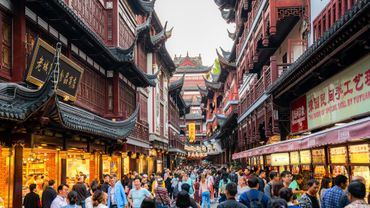will you succumb to the travel trend in 2021?
Domestic tourism has grown in China as well as in the United States and Europe, due to the borders closed during the pandemic. This trend could weigh in the future on international tourism, which must consider a later and virtuous recovery.
International tourist arrivals have down 83% in the first quarter of 2021 due to the maintenance of widespread restrictions on travel, according to the World Tourism Organization (UNWTO). With a 73% drop in arrivals, 2020 has been judged “the worst year in the history of the sector“by the organization.
Tourists visit their country because they cannot cross borders

3 images
Without being able to travel abroad, tourists therefore stayed at home and discovered their country, often encouraged by their governments.
In China, “it has been a while since there has been a reappropriation of Chinese culture by the young generation and a will of the government to repatriate the money“of tourism, according to the specialist in the evolution of socio-cultural trends Cécile Poignant.
With the pandemic, the Chinese traveled on their “very large territory“,”between Tibet, Hainan, Sishuan, there are plenty of interesting places to visit” and the “travel agencies are developing in this direction“, according to her.
To encourage domestic tourism, the Chinese government has for example authorized duty-free in its island province of Hainan which is very popular with young affluent populations with its beaches and luxury hotels.
In a study earlier this year in which it announced that the domestic market would be the engine of the recovery, the McKinsey firm noted the “China rebound“who already has found “80% of its tourism activity“ and an “nature destination quest“young wealthy customers.
The staycation is here to stay

3 images
In the United States, local tourists represented 95% of tourism revenue in 2020, ten points more than in 2019, according to the World Trade and Tourism Council (WTTC), which brings together the major operators of global tourism.
Europeans are also encouraged to travel home, like the French with “summer blue, white, red“touted by the government or vouchers offered to Luxembourgers. At best, travel will be intra-European.
Read also : The Drôme offers gift vouchers to its holidaymakers
“The real movement that we have observed and that we will still observe this summer is the sum of domestic tourism. It is a phenomenon that is lasting“, according to Sébastien Manceau, partner expert in tourism at the Roland Berger firm, interviewed by AFP.
Tourism on stand-by until 2022
Overall, 60% of experts do not expect a rebound in international tourism until 2022, according to the UNWTO and half of them do not expect a return to 2019 levels before 2024.
“This crisis has greatly favored domestic tourism“, confirms Didier Arino, at the head of the consulting company Protourisme which sees it”a very good thing“.
“We cannot want to reduce the impact of tourism on the environment, and not rejoice in the development of local or domestic tourism. The arrival of foreign customers represents 70% of CO2 emissions linked to tourism“, he adds.
Read also : Sustainable tourism: 7 tips to get you started today
“It leaves traces of two summers of domestic markets, but positive traces“, adds Sébastien Manceau for whom”taking the environment into account is increasingly important“.
According to a study conducted by his firm, 58% of Europeans, and 62% of French people, take environmental criteria into account when organizing their stay.
“The Covid-19 crisis has accelerated transformations already underway in the tourism sector: what should have taken five years or more only took a few months“, underlines Mr. Manceau.




